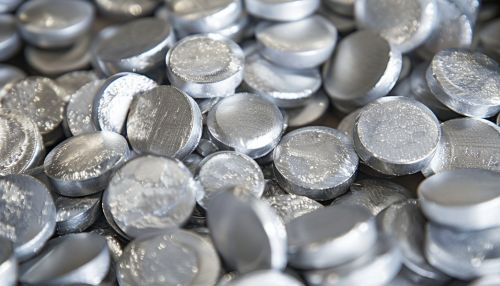Aluminum phosphide
Introduction
Aluminum phosphide (AlP) is a highly toxic inorganic compound used primarily as a fumigant and pesticide. It appears as a dark gray or yellowish crystalline solid and is known for its rapid release of phosphine gas when it comes into contact with moisture. Due to its potent pesticidal properties, aluminum phosphide is widely employed in agriculture for the control of pests in stored grain and other commodities.
Chemical Properties
Aluminum phosphide is composed of aluminum and phosphorus, with the chemical formula AlP. It crystallizes in a zinc blende structure, similar to that of zinc sulfide. The compound is highly reactive, especially with water, leading to the release of phosphine (PH₃) gas, a highly toxic and flammable substance.
Physical Properties
Aluminum phosphide is a dark gray or yellowish solid with a density of approximately 2.85 g/cm³. It has a melting point of around 1,100°C (2,012°F) and is insoluble in most organic solvents. The compound is known for its high reactivity with water, which is a critical factor in its use as a fumigant.
Synthesis and Production
The synthesis of aluminum phosphide typically involves the direct combination of elemental aluminum and phosphorus at high temperatures. This reaction can be represented by the following equation: \[ 4Al + P_4 \rightarrow 4AlP \]
The process requires careful control of temperature and pressure to ensure the formation of pure aluminum phosphide. Industrial production often involves the use of specialized equipment to handle the reactive nature of the starting materials and the final product.
Applications
Aluminum phosphide is primarily used as a fumigant and pesticide. Its ability to release phosphine gas upon exposure to moisture makes it highly effective in controlling pests in stored grain and other agricultural products. The gas penetrates deeply into storage areas, killing insects, rodents, and other pests.
Agricultural Use
In agriculture, aluminum phosphide is used to protect stored grains, seeds, and other commodities from infestation. The compound is typically applied in the form of tablets, pellets, or dust, which then react with atmospheric moisture to release phosphine gas. This gas is highly effective in eradicating pests while leaving minimal residues on the treated products.
Non-Agricultural Use
Beyond its agricultural applications, aluminum phosphide is also used in rodent control and as a fumigant in shipping containers and warehouses. Its ability to produce phosphine gas makes it suitable for use in a variety of settings where pest control is necessary.
Toxicity and Safety
Aluminum phosphide is highly toxic to humans and animals. The release of phosphine gas poses significant health risks, including respiratory distress, pulmonary edema, and even death. Due to its toxicity, the handling and application of aluminum phosphide require strict safety measures.
Health Effects
Exposure to phosphine gas can lead to a range of acute and chronic health effects. Acute exposure may cause symptoms such as headache, dizziness, nausea, and vomiting. Severe exposure can result in respiratory failure, cardiovascular collapse, and death. Chronic exposure may lead to long-term respiratory and neurological damage.
Safety Measures
To mitigate the risks associated with aluminum phosphide, several safety measures are recommended:
- Use of personal protective equipment (PPE) such as gloves, masks, and protective clothing.
- Proper ventilation in areas where aluminum phosphide is applied.
- Training for workers handling the compound to ensure they understand the risks and safety protocols.
- Storage of aluminum phosphide in airtight containers to prevent accidental exposure to moisture.
Environmental Impact
The use of aluminum phosphide has both positive and negative environmental impacts. While it is effective in controlling pests and reducing crop losses, its toxicity poses risks to non-target organisms and the environment.
Positive Impact
By protecting stored grains and other commodities from pests, aluminum phosphide helps to reduce food waste and improve food security. Its use can lead to higher yields and better quality of agricultural products.
Negative Impact
The release of phosphine gas can have detrimental effects on non-target species, including beneficial insects, birds, and mammals. Additionally, improper disposal of aluminum phosphide can lead to environmental contamination. Therefore, it is crucial to follow proper application and disposal guidelines to minimize its environmental footprint.
Regulatory Status
Due to its high toxicity, the use of aluminum phosphide is regulated in many countries. Regulatory agencies such as the Environmental Protection Agency (EPA) in the United States and the European Chemicals Agency (ECHA) in the European Union have established guidelines for its safe use, handling, and disposal.
Registration and Approval
In most countries, aluminum phosphide must be registered and approved by relevant authorities before it can be used. This process involves a thorough evaluation of its safety, efficacy, and environmental impact. Manufacturers are required to provide detailed information on the compound's properties, usage instructions, and safety measures.
Restrictions and Bans
Some countries have imposed restrictions or bans on the use of aluminum phosphide due to its toxicity. These restrictions may include limitations on the types of crops that can be treated, the maximum allowable concentrations, and the required safety measures for handling and application.
Alternatives
Given the risks associated with aluminum phosphide, there is ongoing research into alternative pest control methods. These alternatives aim to provide effective pest management while reducing the health and environmental risks.
Biological Control
Biological control involves the use of natural predators, parasites, or pathogens to manage pest populations. This method can be an effective and environmentally friendly alternative to chemical pesticides. Examples include the use of parasitic wasps to control insect pests and Bacillus thuringiensis (Bt) bacteria to target specific insect larvae.
Integrated Pest Management (IPM)
Integrated Pest Management (IPM) is a holistic approach to pest control that combines multiple strategies to achieve effective and sustainable results. IPM may include the use of biological control, cultural practices, mechanical methods, and selective use of chemical pesticides. The goal is to minimize the reliance on chemical treatments and reduce the overall impact on the environment.
Chemical Alternatives
Several chemical alternatives to aluminum phosphide are available, including magnesium phosphide, sulfuryl fluoride, and carbon dioxide fumigation. These alternatives vary in their efficacy, safety, and environmental impact, and their use may be subject to regulatory approval.
Conclusion
Aluminum phosphide is a powerful and effective fumigant widely used in agriculture and pest control. Its ability to release phosphine gas upon exposure to moisture makes it highly effective in eradicating pests in stored grains and other commodities. However, its high toxicity poses significant health and environmental risks, necessitating strict safety measures and regulatory oversight. Ongoing research into alternative pest control methods aims to provide safer and more sustainable options for managing pest populations.


